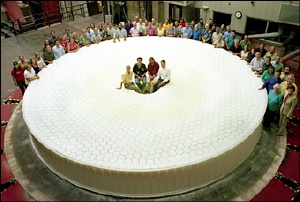Sep 2 2008
The single-piece primary and tertiary mirror blank cast for the LSST is "perfect", say project astronomers and engineers.
 Members of the team building the LSST, a large survey telescope being built in Northern Chile, gather to celebrate the successful casting of the telescope's 27.5-foot-diameter mirror blank. Image credit: Howard Lester / LSST Corporation
Members of the team building the LSST, a large survey telescope being built in Northern Chile, gather to celebrate the successful casting of the telescope's 27.5-foot-diameter mirror blank. Image credit: Howard Lester / LSST Corporation
The LSST, or Large Synoptic Survey Telescope, a large survey telescope being built in northern Chile, requires three large mirrors to give crisp images over a record large field of view. The two largest of these mirrors are concentric and fit neatly onto a single mirror blank. The single-piece primary and tertiary mirror blank emerged from the oven at the University of Arizona’s Steward Observatory Mirror Lab in Tucson, AZ, where team members gathered to celebrate this major milestone.
The Mirror Lab team opened the furnace for a close-up look at the cooled 51,900-pound mirror blank, which consists of an outer 27.5-foot diameter (8.4-meter) primary mirror and an inner 16.5-foot (5-meter) third mirror cast in one mold. It is the first time a combined primary and tertiary mirror has been produced on such a large scale.
In January 2008, LSST announced receipt of two major gifts: $20 million from the Charles Simonyi Fund for Arts and Sciences, and $10 million from Bill Gates. These gifts are being used to enable the construction of LSST's three large mirrors. The finished mirror is scheduled to be delivered in 2012.
The LSST will be the widest, fastest, deepest eye of the new digital age when it begins science operations from Cerro Pachón, Chile, in 2015. It will provide time-lapse digital imaging across the entire available night sky every three days, mapping the structure of our dynamic universe and exploring the nature of dark matter and dark energy.
The LSST research and development effort is funded in part by the National Science Foundation under Scientific Program Order No. 9 (AST-0551161) and Scientific Program Order No. 1 (AST-0244680) through Cooperative Agreement AST-0132798. Additional funding comes from private donations, and in-kind support at Department of Energy laboratories and other LSSTC institutional members.
In 2003, the LSST Corporation was formed as a non-profit 501(c)3 Arizona corporation with headquarters in Tucson, AZ. Membership has since expanded to twenty five members including Brookhaven National Laboratory, California Institute of Technology, Carnegie Mellon University, Chile, Columbia University, Google Inc., Harvard-Smithsonian Center for Astrophysics, Johns Hopkins University, Kavli Institute for Particle Astrophysics and Cosmology - Stanford University, Las Cumbres Observatory Global Telescope Network, Inc., Lawrence Livermore National Laboratory, National Optical Astronomy Observatory, Princeton University, Purdue University, Research Corporation, Rutgers University, Stanford Linear Accelerator Center, The Pennsylvania State University, The University of Arizona, University of California at Davis, University of California at Irvine, University of Illinois at Urbana-Champaign, University of Pennsylvania, University of Pittsburgh, and the University of Washington.